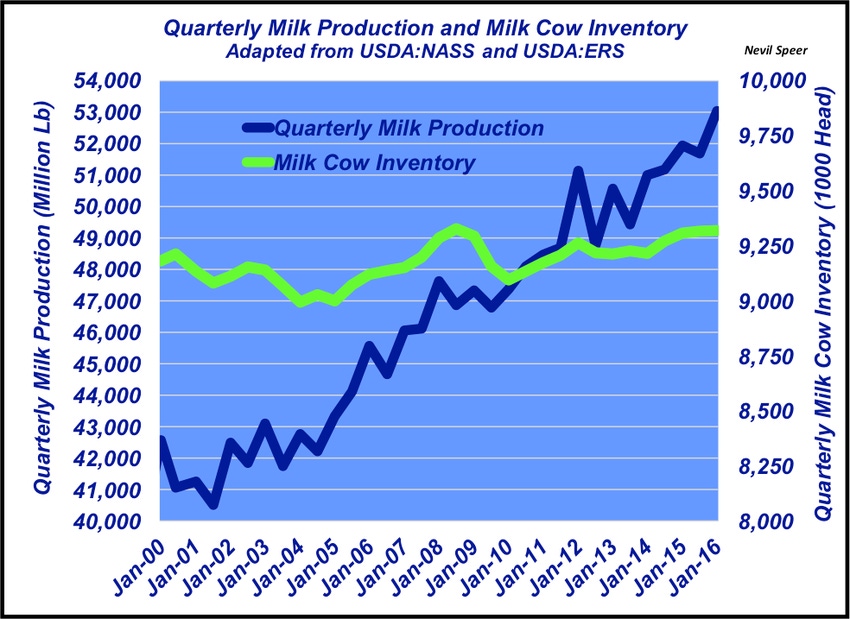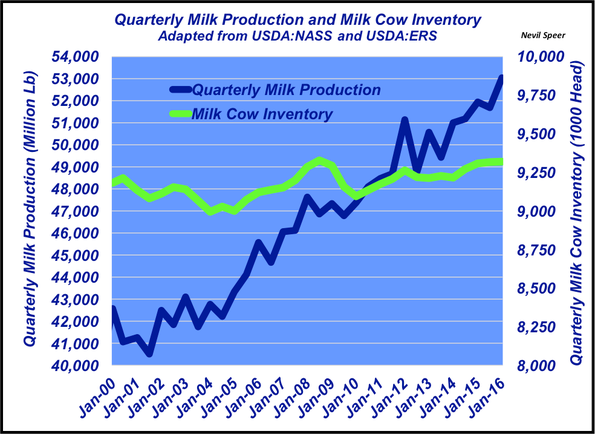Dairy producers have increased milk production 25% over the past 15 years with the same number of cows. Do consumers consider milk as a protein substitute for beef?
October 10, 2016

One of the major influences on the market this year stems from the overall increase in protein supply across all three species – beef, pork and poultry. As noted in a previous column, exports are the key to keeping supply moving: “The meat industry experienced a sharp decline during the past decade. However, that trend reversed sharply in 2015 and is likely to experience further upside in 2016. That largely stems from bigger production: USDA is currently forecasting annual beef, pork and poultry production up 1.25, 0.5, and 1.02 billion pounds respectively in 2016.
“With expanding production comes the requirement for growing access to international markets. Stated another way, export slowdowns could result in even bigger supply within the domestic market; that is, product stays home versus being shipped to other countries. And if exports begin to slow, the required domestic clearance could become much larger versus the current USDA forecasts, mandating lower prices.”
Meanwhile, another important source of protein comes from the dairy industry. To that end, this week’s illustration highlights the dairy industry’s productivity success over time. For example, in 2000, the industry produced 167.3 billion pounds of milk with an average inventory of 9.2 million cows.

Fast forward to 2016. The U.S. dairy industry will likely produce in excess of 210 billion pounds of milk this year with only 9.3 million head. In other words, in just a little over 15 years, the dairy industry has ramped up production by in excess of 25% with nearly the same number of cows.
Bottom line, the increased production means more protein in the consumer market that we often don’t consider as being competition. And the market forces are just the same for dairy protein as described above for meat supplies. That is, consistent increases in production require bigger exports, or else that supply stays at home in the domestic market.
The dairy industry has proven successful in marketing those supplies domestically. With the current consumer mindset, dairy protein is seemingly increasingly competitive as a substitute for beef, pork and poultry – that’s especially true considering the marketing success in recent years around yogurt and whey protein supplements.
How do you perceive the productivity trends that have occurred within the dairy industry? What’s your perception of the substitute effect of dairy versus meat? Where do you see those trends headed? Leave your thoughts in the comments section below.
Nevil Speer is based in Bowling Green, Ky., and serves as vice president of U.S. operations for AgriClear, Inc. – a wholly-owned subsidiary of TMX Group Limited. The views and opinions of the author expressed herein do not necessarily state or reflect those of the TMX Group Limited and Natural Gas Exchange Inc.
You might also like:
15 favorites from fall photos on the ranch
4 questions to ask before marketing 2016 calves
9 new pickups for the ranch in 2016
Seven keys to ranch profitability
How to cull the right cow without keeping records
Burke Teichert's top 5 tips on bull selection
Young ranchers, listen up: 8 tips from an old-timer on how to succeed in ranching
About the Author(s)
You May Also Like



.png?width=300&auto=webp&quality=80&disable=upscale)
.png?width=300&auto=webp&quality=80&disable=upscale)
